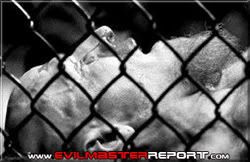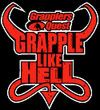The new big thing in blood sports

By Tony Saxon
It's mid-evening on a dreary Saturday night in February and the normally subdued scene at the Arena Bar and Grill just off downtown Guelph is quickly becoming energetic and crowded. Soon people will be turned away at the door.
Not long ago, middle-aged men, nursing bottles of Canadian or Blue, were the patrons on big Saturday nights at the bar. They gathered to watch major boxing pay-per-view events between the likes of Evander Holyfield and Mike Tyson.
But these days it's crowds of 20-somethings pounding back vodka and Red Bulls or double rye-and-gingers as they cheer on combatants named Randy Couture, Georges St. Pierre and Mirko "Cro Cop" Filipovic.
It's mixed martial arts, the new big thing in blood sports. Two fighters use a variety of martial arts, boxing and wrestling moves to try to knock out their opponent or get him to give up by "tapping out" -- MMA lingo for conceding defeat by tapping their hand on the mat or on their opponent's back.
Over two million people tuned into the season finale of the cable television reality show Ultimate Fighter last year. Hundreds of thousands purchased the latest pay-per-view event and over 19,000 people packed Nationwide Arena, in Columbus, Ohio, to watch it live.
Although official fights are not allowed in Ontario, the sport's disciplines can be taught, and mixed martial arts gyms are popping up all over. One is set to open soon in Guelph.
"This thing is definitely here to stay. It's not a fad," says Gary Artugo, partner in Guelph's Stay Fit Health Centre, which will soon open the 2,500-foot Elite Fighting Academy within its confines to teach MMA.
Over 60 people had signed up weeks before its scheduled opening.
To some, MMA is a dangerous, brutal and often bloody street fight. It is banned in many U.S. states and several provinces, including Ontario.
But to supporters it is a human chess match between two trained athletes: man-to-man competition at its finest with roots in the ancient Olympics.
"It's just a huge adrenalin rush," says Guelph's Dave Merkley, an MMA fan who made the six-hour drive to Columbus for the last Ultimate Fighting Championship card. Not only was it sold out on fight night, there were also 5,000 people in the stands the night before to watch the competitors weigh in.
"I've been at boxing events and the feeling is nothing compared to MMA," Merkley says.
Ultimate Fighting Championship is the major professional organization credited with legitimizing the sport by creating more rules and a safer environment.
Rory McDonell was bitten by the MMA bug in a different way.
The University of Guelph student was introduced to the sport by the crew of professional fighters who regularly find their way to the Guelph Wrestling Club to hone their wrestling skills. Respected wrestling club assistant coach Dave Mair was in Jeff Joslin's corner the night he lost an Ultimate Fighting Championship bout in San Diego.
Now McDonell is training seven days a week, adding martial arts tools to his already-established wrestling arsenal in time for his second pro fight April 7 in Winnipeg for the Ultimate Cage Wars organization, one of several lower-level professional organizations that hold fights outside the province.
He, too, hopes for the day that MMA cards will be held in Ontario.
"It would be incredible to be able to fight in front of family and friends," McDonell says.
Mixed martial arts fights have come a long way since their modern roots as a bloodletting between two often mismatched opponents that was the Ultimate Fighting Championship of the early 1990s.
"It's not the blood sport it was in the early '90s," McDonell says. "You don't get the thugs you used to."
There are more rules, weight classes, a doctor at ringside and better-trained competitors than in the early days. MMA proponents now claim it is a safer sport than boxing.
But that hasn't swayed the Ontario government, which has banned live MMA competitions, both amateur and professional.
Ontario Athletics Commission commissioner Ken Hayashi sounds a little tired of answering the question "why?"
"They have to have regulations for it -- it's the only way they can do it," Hayashi says of those looking to get the sport legalized in Ontario. "What they need to do is get themselves established as an amateur organization."
Asked why MMA cards are allowed in several other provinces, Hayashi says "I can't speak as to what other provinces have done."
"Getting established as an amateur organization" means establishing an amateur base, getting the necessary number of participants and creating a certification and training program for coaches and referees.
That's the point the Ontario Mixed Martial Arts Association is at now.
The man leading the charge to get MMA recognized in Ontario is a Toronto accountant named Marco Antico.
A longtime MMA fan who works on the side as a promoter and talent scout for a Quebec-based MMA organization, Antico says he knew the sport had arrived when he heard two people at his office's water cooler discussing a televised fight the night before.
"Some say it's the next boxing, but it already is the next boxing," says Antico. "It's just a matter of time and perception before it's as big as the NHL or NFL."
Antico says working through the government, and in particular the Ministry of Health and Long-Term Care which overseas the promotion of amateur sport, is the only way for MMA fans to achieve the goal of live fights in Ontario.
"It'll happen one day," says Merkley. "At least I sure hope it does."
tsaxon@guelphmercury.com
MIXED MARTIAL ARTS PRIMER
What is it: A competition between two opponents of similar weight and ability who use a variety of martial arts, boxing and wrestling moves to knock each other out, get their opponent to "tap out" (submit) or win on points awarded by ringside judges.
The rules: Three round (non-title) or five round (title) fights, each five minutes in length. Safety precautions include no hitting the back of the head, spine, groin or throat. No eye-gouging or biting.
The big names: Randy Couture, Chuck Liddell, Frank Shamrock, Mirko "Cro Cop" Filipovic and Canadian Georges St. Pierre.
History: Some trace the sport to the ancient Greek sport of pankration, a combination of wrestling and boxing with few rules. In modern times, it stems from bastardized forms of various martial arts developed in Brazil and Japan and ensuing challenge matches held in those countries.
North American roots: Ultimate Fighting Championship formed in the United States in 1993, holding pay-per-view events with few rules and often mismatched opponents. Public and politician backlash led to banning the sport in many states. By 1997 the sport was no longer on television.
Revival: New ownership in 2001 established new rules, better safety measures and trained participants as opposed to street brawlers. The cable television reality show Ultimate Fighter provided a huge boost in popularity.
Today: Just over 19,000 fans attended the last big fight card in Ohio. Pay-per-view buys now rival or surpass those of major boxing cards. It's also popular in Japan and an upcoming UFC card will be held in England.
In Canada: Professional and amateur mixed martial arts fights are banned in Ontario. A number of lower-level professional organizations exist in Canada, holding cards primarily in Quebec, Alberta and British Columbia.
(Source)






















No comments:
Post a Comment